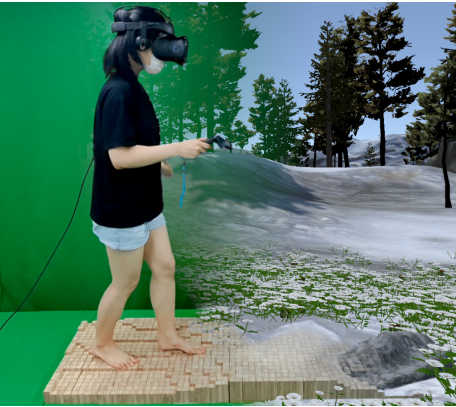| The Floor Moves! |
| Written by Harry Fairhead | |||
| Sunday, 23 May 2021 | |||
|
I have long thought that the real goal of VR is the full "holodeck" experience but this is tough. Now we have a floor that can change to make WYSIWYS - What You See Is What You Step - real KAIST in South Korea and the University of Chicago have built Elevate and the good news is that it is within the reach of many makers to reproduce. The idea is that if you can build a floor that changes its shape as you walk, the user can be fooled into thinking that a VR visual field corresponds to the physical reality. The idea is very simple - 1200 pins which can be raised or lowered under software control by 150mm. OK, going from flat to 150mm isn't going to let you simulate a climbing wall, but steps, stepping stones and rough terrain are all possible. Each pin is a small block of wood and the problem is how to move 1200 pins without needing 1200 actuators. If you think about a typical use then clearly only a few of the blocks need to be positioned quickly and indeed many can be positioned, locked in place and left. The solution is to use a row of actuators which can be moved using a belt drive.
Each actuator is a rack and pinion drive with magnetic sensors for positional feedback:
The wooden blocks also have grooves cut into them, which allows rows to be locked into position before the actuator row moves on.
You can imagine the microprocessors needed to control all of this are pretty minimal. The team used an Arduino, I'd opt for the Raspberry Pi Pico, but you could use whatever you wanted - it's not a difficult control problem. So you have the details of construction - does it work? The best way to find out is to look at the video: Convincing enough to make me think that something bigger would be worth building. Perhaps you could reduce the number of actuators by covering them with a flexible sheet of something - it would make smooth surfaces easier, but steps harder.
More InformationElevate: A Walkable Pin-Array for Large Shape-Changing Terrains Seungwoo Je KAIST, Shan-Yuan Teng University of Chicago, Hyunseung Lim KAIST, Jas Brooks University of Chicago, Andrea Bianch iKAIST, Kongpyung Moon KAIST, Pedro Lopes University of Chicago Related ArticlesWalk A Thousand VR Miles And Never Leave The Room Microsoft Mesh - A Platform For Holoportation MetaLimbs: A Way To Have An Extra Pair Of Arms To be informed about new articles on I Programmer, sign up for our weekly newsletter, subscribe to the RSS feed and follow us on Twitter, Facebook or Linkedin.
Comments
or email your comment to: comments@i-programmer.info <ASIN:1871962684> <ASIN:1871962692>
|
|||
| Last Updated ( Monday, 24 May 2021 ) |





